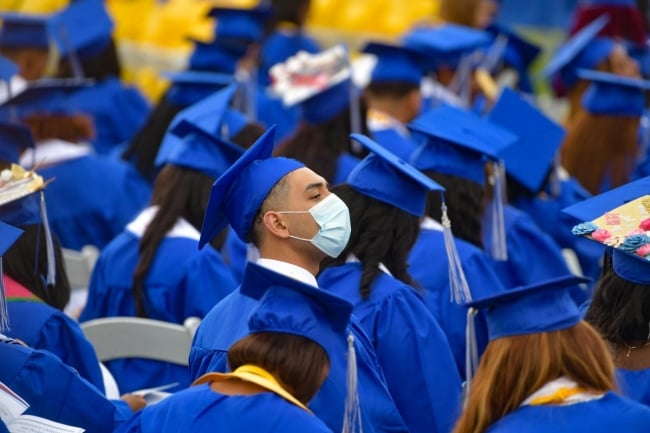You have /5 articles left.
Sign up for a free account or log in.

Numerous financial incentives are in place for students who want to attend Tennessee State University or other public institutions in the state, but those measures might not be enough to get more students to enroll.
Jason Davis/Getty Images
Tennessee higher education officials, like their counterparts across the country, are grappling with declining enrollment at colleges throughout the state. But a precipitous drop in high school graduates enrolling in college—the lowest numbers seen in a decade—has raised alarm bells and prompted state officials to double down on efforts to slow the decline and attract more students.
The officials are also trying to figure out what’s driving a troubling new trend line—first-time enrollment by high school grads are falling despite several programs in place that previously helped increase enrollment.
“I think everybody has the same questions, and everybody is still working on answers,” Linda Martin, the University of Tennessee system’s vice president for academic affairs and student success, said of national enrollment declines.
According to a new report by the Tennessee Higher Education Commission (THEC) released May 23, “College Going and the Class of 2021,” the percentage of Tennessee public high school graduates attending college in the fall semester following their graduation fell from 56.8 percent to 52.8 percent. It was the lowest college enrollment rate since the commission began tracking the numbers in 2011. The rate also dropped sharply in 2020, from 61.8 percent in 2019, a decline that coincided with the COVID-19 pandemic.
Emily House, executive director of the commission, said she was not surprised by the decline in the enrollment rate but it was nonetheless “a shock to the system of higher education.”
“It’s definitely not unique to Tennessee. It’s going to take Tennessee and the nation a long time to overcome this,” she said. “It’s very much a call to action.”
Undergraduate and first-year enrollment rates have declined throughout the pandemic nationally and in individual states. According to an April study by the U.S. Bureau of Labor Statistics, 61.8 percent of 2021 high school graduates nationally were enrolled in college, a slight decline from 2020 but well above Tennessee’s enrollment rate.
Tennessee’s college-going rate did mirror national demographic trends, however. Recent high school graduates in the state who did not enroll in college were disproportionately Black and Hispanic students and from low-income backgrounds. The rate was also lower among students from rural areas than elsewhere in the state.
The state is also similar to others in its efforts to increase the number of state residents with postsecondary degrees or certificates in order to meet labor market needs and fill jobs that currently don’t have enough qualified candidates.
Among those efforts is the state’s Drive to 55 campaign, an initiative started in 2015 designed to raise the percentage of workers with college degrees or other academic credentials in the state to 55 percent by 2025. The percentage was 46.8 percent in 2019, the most recent figure available, according to the College Going report.
Tracking the state’s college-going rates from year to year is an essential component of the Drive to 55 initiative and state higher ed officials’ plans to understand what measures should be taken to improve the numbers. Officials put three statewide programs in place to help achieve that goal: Tennessee Promise, which provides scholarships to high school graduates enrolling in college; Tennessee Reconnect, a tuition-waiver initiative targeted at getting students who stopped out of college to return; and Tennessee LEAP, which matches courses institutions offer to the credentials employers are seeking.
House said members of the THEC; the state Board of Regents, which oversees community and technical colleges; and several nonprofit higher-education foundations and other stakeholders met last week after the college-going report was released and discussed “How do we tweak the services we’re already offering? What can we do bigger and better now? How do we improve the communication and messaging for the services we do have available?”
Russ Deaton, the Board of Regents’ executive vice chancellor for policy and strategy, said they want to determine the status of students who don’t enroll in college after graduating high school.
“If they’re in the labor force, that means we have to be able to make more permeable the space between us and the workforce,” he said, adding that this could be done by more closely examining why students choose jobs over college and by evaluating how the Tennessee Reconnect program can help more students return to college and complete their programs and earn credentials.
Deaton, who is the former deputy executive director of the state higher education commission, said consistent state funding for higher education has likely helped institutions keep their enrollment numbers from declining further by allowing them to offer students scholarships and other financial supports.
“As efficient as these things are, it might not be enough for us,” he said.
The percentage of first-year college enrollment by Tennessee high school graduates rose in 2015, the same year the Tennessee Promise program launched and began covering tuition and fees for students enrolled at state two-year institutions who meet certain income criteria. (Associate degree students at four-year colleges are also eligible.) All 40 public two-year institutions and approximately 20 four-year institutions take part in the program. The University of Tennessee system followed suit five years later with a version of the program called UT Promise, which does the same for students pursuing bachelor’s degrees.
Two-year and four-year institutions in the state offer HOPE Scholarships, started in 2004 and funded by state lottery revenues. The grants are available to in-state high school graduates who meet minimum grade point average and test scores and who enroll within 16 months of high school graduation. They are renewable each semester based on remaining academically eligible. On June 1, the state increased the grant per semester by $600, bringing the grants to as much as $2,850 per semester for students in their last two years of a four-year college degree.
First-year enrollment at the University of Tennessee system rose by 4.9 percent in 2021, and Martin said early projections indicate a similar rise is possible in the fall of 2022. But the increase has only occurred at the flagship Knoxville campus, while the numbers at the Chattanooga and Martin campuses slightly decreased in 2021. The decline at Martin was notable, she said, because of its rural location and because the region was disproportionately hard hit by the pandemic. This resulted in lower numbers of high school graduates from the area going to college.
Undergraduate enrollment at historically Black Tennessee State University in Nashville rose after the pandemic began, from 5,875 in fall 2019 to 6,000 in fall 2020 and to 6,375 in fall 2021, according to the university. That growth was the result of a dedicated recruitment and marketing plan by university officials that recognized the downward trend in the state and nationally, said Terrence Izzard, Tennessee State’s associate vice president for enrollment management. “Sometimes difficult situations cause you to think creatively, and the end result of that is innovation.”
Part of that innovation, he said, was strengthening relationships with education and community leaders in Nashville and around the state and having them remind students that college is a viable, affordable option. It also includes committing more time and money to a partnership with Metro Nashville Public Schools, in which Tennessee State began a mentoring program designed to prepare high school students for college. The university will enhance that commitment in fall 2023 by providing 100 incoming students from Nashville public schools scholarships covering full tuition and fees.
The state’s community colleges, however, suffered overall enrollment losses in the past year that were severe enough to force several institutions to lay off employees and eliminate positions.
For the University of Tennessee system, spreading the message about the scholarships and grants—particularly about UT Promise, which is still relatively new and went into effect during the first year of the pandemic—has grown in importance, Martin said, but so has the idea that all institutions must gauge what students want and need and provide it for them.
“If folks opted out of college during the pandemic, how do we get them back? What are the reasons why they opted out? I think that’s a question we don’t really know, that we need to dig in deeper and learn a little more about,” Martin said. The institutions also have to consider whether any of the learning structures in place today, including semesters, course start dates and hybrid learning, should be altered: “How do we create options for students that are not traditional options?”
House, executive director of the state higher education commission, said, “The conversation is already starting to change” about raising the number of high school graduates going to college in the state. Four days before the college-going report went public, the THEC announced that tuition at state institutions would be frozen for the 2022–23 academic year, to be paid for by a new round of state funding.
House said she could “optimistically” envision some improvement by the fall of this year and noticeable improvement by the fall of 2024.
Both House and Martin are very clear that trying to get “back to normal” pre-pandemic enrollment rates is no longer realistic.
“I think there is an understanding that there is no going back,” House said. “Success is not a matter of going back to the way things were in February 2020. Nobody is operating from that framework.”




